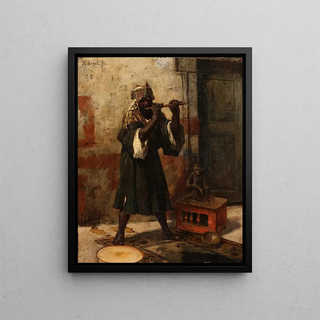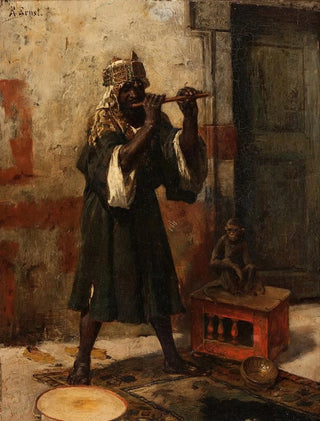Art print | The Snake Charmer - Rudolf Ernst


View from behind

Frame (optional)
In the fascinating world of Orientalist art, Rudolf Ernst's "The Snake Charmer" stands out for its enchanting atmosphere and keen attention to detail. This artwork, which captures the very essence of a scene filled with mystery and seduction, transports the viewer into a world where magic and nature intersect. The artist, with unparalleled mastery, manages to evoke an ambiance that is both exotic and timeless, inviting each observer to ponder the hidden stories behind the gazes of the depicted characters. The art print of this piece not only allows appreciation of the artist's technique but also immerses one in the rich cultural context it conveys.
Style and uniqueness of the work
The Snake Charmer is characterized by a meticulously crafted style that highlights Rudolf Ernst's talent for observation and detailed representation. The vibrant colors, ranging from earthy tones to more striking shades, create a harmonious palette that draws the eye and captures attention. The composition, where the charmer appears both master and slave of his snakes, evokes a palpable tension. Every element, from the richly decorated setting to the expressions of the characters, contributes to full immersion in this scene. The artist succeeds in transmitting an atmosphere of fascination and danger, where the beauty of the charmer blends with the unease caused by the reptiles. This duality is one of the keys that make this work so captivating, as it challenges the viewer on the complexity of the relationship between man and nature.
The artist and his influence
Rudolf Ernst, Austrian painter of the 19th century, is renowned for his ability to translate Oriental influences into his works. An indefatigable traveler, he absorbed the cultures he encountered, offering a unique vision of the Orient through his paintings. His style, marked by striking realism and sensitivity to detail, makes him a prominent figure in Orientalism. Ernst was able to capture the collective imagination of his time, blending romanticism and exoticism, and influenced many artists in the genre.

Matte finish

View from behind

Frame (optional)
In the fascinating world of Orientalist art, Rudolf Ernst's "The Snake Charmer" stands out for its enchanting atmosphere and keen attention to detail. This artwork, which captures the very essence of a scene filled with mystery and seduction, transports the viewer into a world where magic and nature intersect. The artist, with unparalleled mastery, manages to evoke an ambiance that is both exotic and timeless, inviting each observer to ponder the hidden stories behind the gazes of the depicted characters. The art print of this piece not only allows appreciation of the artist's technique but also immerses one in the rich cultural context it conveys.
Style and uniqueness of the work
The Snake Charmer is characterized by a meticulously crafted style that highlights Rudolf Ernst's talent for observation and detailed representation. The vibrant colors, ranging from earthy tones to more striking shades, create a harmonious palette that draws the eye and captures attention. The composition, where the charmer appears both master and slave of his snakes, evokes a palpable tension. Every element, from the richly decorated setting to the expressions of the characters, contributes to full immersion in this scene. The artist succeeds in transmitting an atmosphere of fascination and danger, where the beauty of the charmer blends with the unease caused by the reptiles. This duality is one of the keys that make this work so captivating, as it challenges the viewer on the complexity of the relationship between man and nature.
The artist and his influence
Rudolf Ernst, Austrian painter of the 19th century, is renowned for his ability to translate Oriental influences into his works. An indefatigable traveler, he absorbed the cultures he encountered, offering a unique vision of the Orient through his paintings. His style, marked by striking realism and sensitivity to detail, makes him a prominent figure in Orientalism. Ernst was able to capture the collective imagination of his time, blending romanticism and exoticism, and influenced many artists in the genre.






